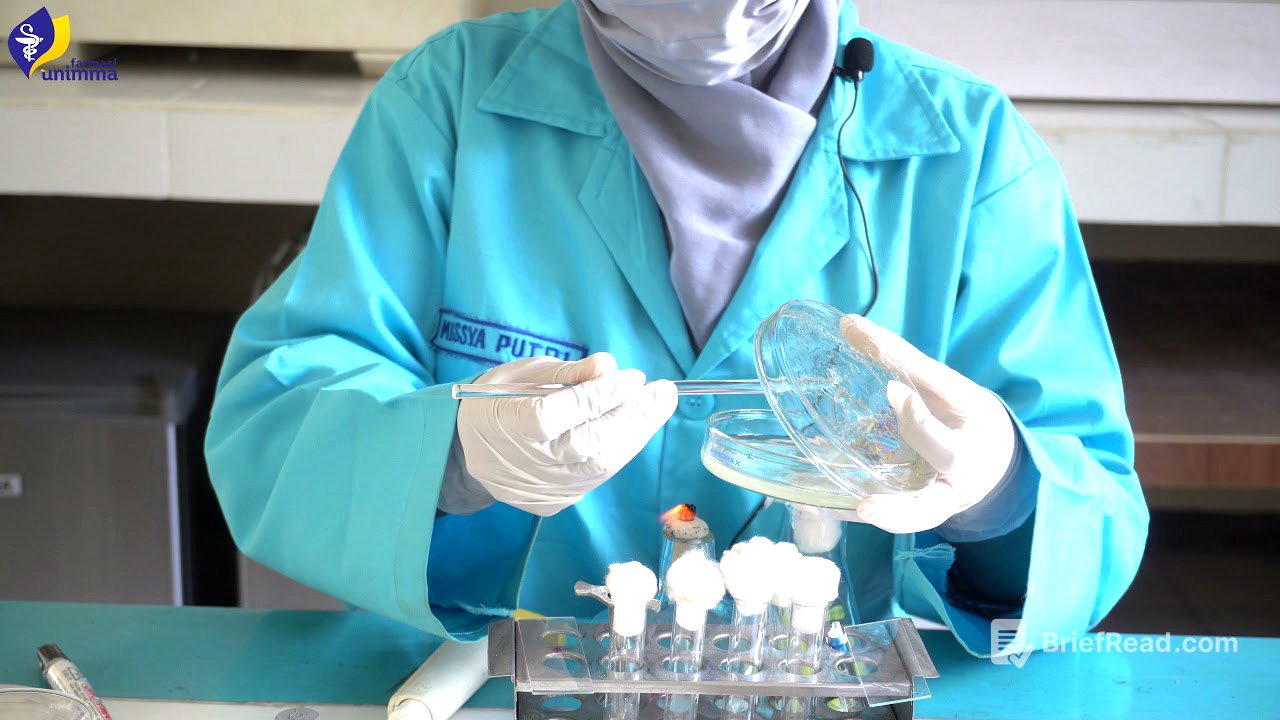TLDR;
This video provides a step-by-step simulation of the agar diffusion method, also known as the well method, for testing antibacterial activity. It demonstrates how to prepare bacterial suspensions, create antibiotic solutions, inoculate media, and measure inhibition zones. Key steps include creating wells in the agar, filling them with different concentrations of the test solution, incubating the media, and measuring the resulting clear zones to determine antibacterial effectiveness.
- Preparation of bacterial suspension and antibiotic solutions.
- Inoculation of bacteria onto the agar media using the spread plate method.
- Creation of wells in the agar and filling them with varying concentrations of the antibiotic solution.
- Incubation of the agar plates and measurement of the inhibition zones to assess antibacterial activity.
Introduction [0:00]
The video introduces a simulation of the agar diffusion method, or well method, used to test the antibacterial activity of substances. The goal is to determine how well an antibacterial agent inhibits bacterial growth by observing the inhibition zone, or clear zone, around the wells in the media.
Tools and Materials [0:43]
The tools and materials used in the experiment include a Staphylococcus aureus bacterial suspension, chloramphenicol antibiotic as the test solution, distilled water as the solvent, and Muller Hinton agar as the test medium. Additional tools include a spreader (speed glass) for inoculating bacteria, a software to create wells in the media, and sterilized micropipettes with tips for transferring the test solution.
Preparing the Solutions [1:58]
The process begins with preparing a 2% chloramphenicol solution by dissolving it in distilled water. Serial dilutions are then made to create solutions with concentrations of 1%, 0.5%, and 0.25%. These varying concentrations will be used to assess the antibacterial activity at different levels.
Inoculating the Media [2:42]
100 microliters of the Staphylococcus aureus bacterial suspension are inoculated onto the Muller Hinton agar. The suspension is spread evenly across the surface of the media using a sterilized spreader. After spreading, the media is left for 5-10 minutes to allow the suspension to absorb properly.
Creating and Filling the Wells [4:34]
Wells, each 6 mm in size, are created in the agar using a software. Four wells are made to accommodate the four different concentrations of the chloramphenicol test solution. The wells are spaced to prevent the inhibition zones from overlapping. Each well is filled with 20 microliters of the corresponding chloramphenicol solution, ensuring each concentration is tested separately.
Incubation and Observation [7:18]
After filling the wells, the test solution is allowed to absorb into the media. The agar plate is then incubated at 37° Celsius for 18-24 hours. Following incubation, the plates are observed for the formation of clear zones around the wells, indicating antibacterial activity. The diameter of any formed inhibition zones is measured using a vernier caliper or ruler to quantify the effectiveness of the antibacterial agent.
Comparison with Disc Diffusion Method [7:57]
The video briefly contrasts the well method with the disc diffusion method, noting that the latter uses paper discs soaked in the test substance instead of creating wells in the agar. In the well method, the test sample is placed directly into the wells. The diameter of the inhibition zone is then measured to assess the toxicity or effectiveness of the antibacterial agent.





![[ Official Pilot ] Cranium ปริศนาซากมรณะ](https://wm-img.halpindev.com/p-briefread_c-10_b-10/urlb/aHR0cDovL2ltZy55b3V0dWJlLmNvbS92aS9sZ2JRS3pvbGlZNC9ocWRlZmF1bHQuanBn.jpg)



